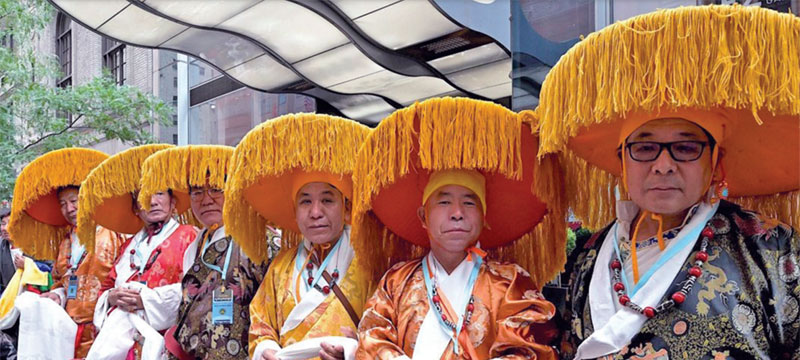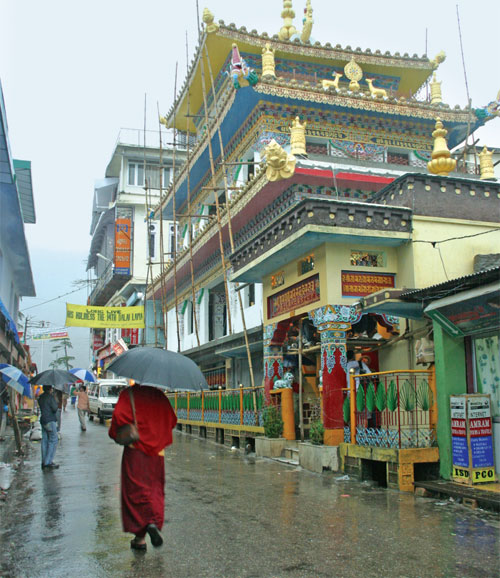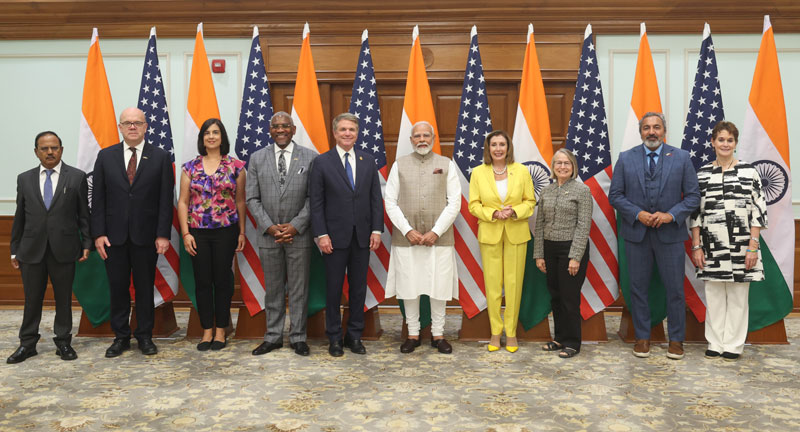India gave up the Tibet card in 2003
Pravin Sawhney
On 19 June 2024, a bipartisan delegation of US lawmakers led by the US Chair on foreign affairs committee, Michael McCaul and including former House speaker, Nancy Pelosi met the Dalai Lama in Dharamshala to present him a copy of the recently passed ‘Resolution to Tibet China Dispute Act’ commonly referred to as the ‘Resolve Tibet Act.’ The Act passed on June 12 by both the Senate and the House now awaits the President’s clearance to become, what is easily the most contentious piece of legislation between the US and China since the US, in 2020, declared China in its National Security Strategy and National Defense Strategy, as its biggest (global geopolitical) competitor and the ‘pacing threat’ in this century.

Equally significant are two other issues concerning the Act. The US lawmakers chose to travel to Dharamshala to present the bill from India soil, even as the Dalai Lama was scheduled to travel on June 21 to the US for medical treatment. And, by welcoming the US delegation at the highest level—Prime Minister Modi met them—, India signaled to China that the US bill had its total support and encouragement.
By its act, the US lawmakers unequivocally indicated to China that a new security competition front against China, from Indian soil, had been opened. By the same logic, China would have assessed that the Modi government too (believing that it is in competition with China in regional geopolitics) had opened a security competition front against the Xi Jinping regime. While the US, as a great power competing with another great power China will get away with its provocation, India as a medium power might end up regretting its hollow bravado.
From the US perspective, security competition relates to use of military power in grey zone operations. Since, between two peer military competitors, the line between security competition, conflict, and war is thin, it is important for both sides to maintain strategic and military communications to keep unintended escalation in check. This explains why the US military had been asking China to keep open lines of communications since Washington started severe security competition in Taiwan Strait and the South China Sea (SCS). To recall, it was US House Speaker Nancy Pelosi’s visit to Taiwan in August 2022 (which China strongly objected to) that opened a severe security competition there. And, with the creation of the military alliance called SQUAD (consisting of the US, Japan, Australia and Philippines) in May 2024, the US had opened the second security competition front in SCS against China. The purpose of the security fronts in Taiwan and SCS is to contain the PLA in the first island chain, while the purpose of the front from the India soil in to put pressure on the PLA tasked with safeguarding Chinese commercial ships traversing through the 3,000 nautical miles in the Indian Ocean region.
Coming to the Resolve Tibet Act, it has two objectives. The first is to provide funds to the US state department to facilitate the US special representative for Tibet affairs to counter Chinese disinformation on Tibet always being a part of China. And the second objective is to nudge China to start negotiations without any preconditions with the Dalai Lama or his representative (Central Tibetan Administration [CTA] or the government-in-exile based in Dharamshala) for the status and governance of Tibet. This objective is unrealizable since the Tibet sought by the Dalai Lama does not exist any longer, and the US lawmakers, India and the world knows this.
The Dalai Lama announced his vision for Tibet on 15 July 1988 at the European Parliament in Strasbourg. Called the ‘Middle Way Approach’ or the ‘Middle Path’, it sought genuine autonomy for Tibet within China. While the Dalai Lama did not seek independence from China, Beijing, on hearing his Strasbourg speech labelled him a ‘splittist’, one determines to unravel China’s political map. There were two irreversible issues with the Dalai Lama’s demands.
The first one is that the Tibet (or greater Tibet) that the Dalai Lama wants had not existed since the 18th century, when the Qing dynasty of China had annexed Amdo and parts of the Kham provinces. Over the next century, various Chinese dynasties continued to nibble at these provinces, gradually integrating them with Chinese provinces of Qinghai, Sichuan, Gansu, Yunnan and Xinjiang. What remained in control of the Dalai Lama (or Tibetan monks) was the U-Tsang province and some parts of Kham. Of course, the Tibetans never accepted this disembowelment, and continued to raise this matter with both the Chinese rulers as well as the British India government, but without success. In any case, in 1907, ending their great game contestations over Central Asia and Afghanistan, Britain and Russia acknowledged Chinese suzerainty over Tibet.
In 1950, after its annexation of the U-Tsang province, euphemistically referred to as ‘liberation of Tibet’, leading to the secret escape of the Dalai Lama to India in 1959 (which was seen as Mao Zedong’s personal failure), China integrated U-Tsang with remaining parts of Kham and renamed the area as Tibet Autonomous Region (TAR). The Dalai Lama’s Middle Path proposal harked back to this old Tibet, including Amdo and the whole of Kham (the Dalai Lama incidentally is from the Amdo province). To expect China to fragment its provinces and re-do its political map to accommodate the Dalai Lama’s proposal is not possible.
The other demand is equally undoable. The Dalai Lama wants that China allows Tibetans self-determination which implied that they should have freedom to pursue their unique cultural, linguist, religious, and historical identity. In short, while China control defense and foreign policy of Tibet, all other attributes of governance including an independent judiciary should be the responsibility of the CTA. Moreover, the Dalai Lama wants minimal PLA presence in Tibet.
Considering that TAR’s demography has changed with huge Hans Chinese population living there, which in turn has brought mainland China’s governance and economic models, it will not be possible for Beijing to reverse the clock. Regarding the PLA, after its 2015 reforms which created the Western Theatre Command (PLA’s largest geographic command), hundreds of thousands of PLA soldiers are stationed in TAR, which has become their permanent habitat, training ground, and operational base to launch assaults without warning time (called Cold Start) against the Indian military. Here, unlike the Taiwan Strait and SCS, India will need to face Chinese military threat with minimal (and mostly invisible) support from the US since India does not have a military alliance with the US. Given this, let’s examine the huge military challenge that the Modi government has brought upon itself by its mindless support to the US’s Tibet agenda.
India’s Tibet Challenge
Indian government’s support to the US agenda on Tibet has, according to seasoned Indian analysts, revived India’s Tibet card or the Dalai Lama card. What this means is that China will come under pressure on the Tibet issue since the Dalai Lama, the revered spiritual leader of the Tibetans, is based in India. The reality is that if there was indeed a Tibet card, it got over in 2003, worse, the whole idea is likely to boomerang on India with disastrous consequences. To understand this, three key issues need to be put into perspective.

The first relates to Prime Minister Atal Bihari Vajpayee’s visit to China in 2003 when India formally conceded that TAR was a part of China. To understand this, one needs to go back to the 1914 Simla agreement between three parties: representatives of Tibet, China, and of the British India, Sir Henry McMahon. Sir Henry drew the McMahon line to divide British India from Tibet by dividing Tibet into outer Tibet and inner Tibet. While McMahon and the Tibetan representative signed on the new map, the Chinese representative did not do so. Moreover, China, unlike the other two parties, did not ratify the agreement. The Chinese objection to the McMahon line (which they did not disclose until 2009) was that the division of Tibet was unacceptable to them. The area between the McMahon line and outer Tibet is 90,000 square kilometres which, on India’s Independence, came to be known as the North-East Frontier Agency (NEFA) of the Assam province. Later, NEFA became India’s state of Arunachal Pradesh in 1987. Once China occupied Tibet, it called it Xizang.
By accepting that TAR was a part of China, Vajpayee government surrendered its Tibet card. In contrast, in 2009, China said that India’s state of Arunachal Pradesh was south Tibet (earlier outer Tibet) called Zangnan and it belonged to China. Soon, China started giving stapled visas to people from Arunachal Pradesh visiting China. Moreover, to establish its historical claim, China, in four tranches, gave Tibetan names to places, rivers, mountains and other prominent features in Arunachal Pradesh. A total of 62 names were changed in 2017, 2021, 2023, and 2024. Interestingly, all this happened under the Modi government. While India has been dismissive about China’s claim on Arunachal Pradesh, China, since 2015, started showing India on its official maps without Arunachal Pradesh and Kashmir (which China says is disputed between India and Pakistan).

The second issue relates to China’s one-China policy, which according to Beijing is the basis of China’s relations with any nation. In 1979, the US signed on the one-China policy after it recognised that instead of Taiwan, the People’s Republic of China was the sole legal government of China. India too recognised the one-China policy. However, in Modi government’s second term in office starting 2019, India stopped mentioning one-China policy in its formal and informal communications. Whenever asked, India took the position that its stand on China is well known and there was no need for reiteration. On ending his term in office in India, China’s previous ambassador to India, Sun Weidong explicitly stated that one-China policy was the basis of bilateral relations between the two countries.
What escapes notice of many in India is that one-China policy for India is not the same as for the rest of the world. While for the rest of the world with ties with China, the policy refers to Taiwan being a part of China, for India, it is about Zangnan (Arunachal Pradesh) being a part of China. This issue assumes importance for two reasons. One, in June 2023, US President Joe Biden in an interview to CNN (Fareed Zakaria) spoke about China. He said that Xi Jinping did not want war and China was not an expansionist power. But Xi will reclaim what belongs to China. So, the two issues over which China will not hesitate to fight are Taiwan and Tibet which it says belong to it.
And two, during the over four-year-old military standoff between India and China in east Ladakh, China has repeatedly said that the issue is not about border dispute (as India believes), but about sovereignty. The moot issue is that what was a border dispute for China during the 1962 war is today an issue of its sovereignty where a give and take of territory for absolute peace is ruled out. According to China, the way forward for normalization of ties between China and India is to focus on the big (geopolitical) picture by treating the border issue as one area of disagreement to be resolved at its own pace. Instead of considering the Chinese proposal for a win-win way forward, the Modi government, inspired by the US lawmakers, has initiated a regional security competition with China.

This brings us to the third issue on the future of security competition between India and China. Here, India has three challenges: the PLA and the Pakistan military are tied at the hip, so, a war with one will become a two-front war. Moreover, involved in counter terror operations in Jammu and Kashmir since 1991, the Indian generals have risen in rank and stature believing that CT ops is their forte. They are unmindful of the fact that CT ops is a tactical level operations worthy of being led by junior officers, while generalship has always been about building credible deterrence which has not been done. Furthermore, Indian military today faces the PLA which is at the edge of modern warfare competing with the most powerful military in the world: US military.
Underplaying the above challenges and supported by the Prime Minister himself who publicly declared that ‘this was not an era of war’, the Indian military leadership has conflated war for sovereignty (occupation of huge territory) with grey zone operations on the Line of Actual Control with China. While India is prepared for the grey zone operations, it has still to come to grips with the two sets of PLA’s structural reforms under Xi Jinping done in 2015 and April 2024. What it means is this: if China decides to reclaim its territories, it will be Tibet and not Taiwan. While the US and China will remain engaged for perhaps a decade in a severe security competition in west Pacific, a war, if it happens, will be between India and China plus Pakistan combined.
The reason for this is that in a war between China and the US, neither side will be able to exercise escalation control which while not achieving their war objectives could lead to unintended escalation which could be disastrous for both great powers. In the case of a war between India and China, the PLA will have total escalation dominance (details in my book: The Last War). This will result in a short, swift, intense, sudden and whole-of-nation war of occupation. For this reason, India should reconsider its decision to support US agenda on Tibet.

